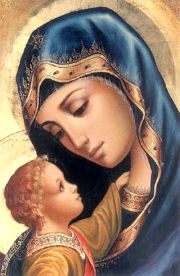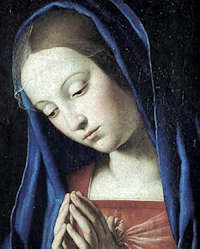Ordinary Time: September 12th
Monday of the Twenty-Fourth Week in Ordinary Time; Optional Memorial of the Most Holy Name of the Blessed Virgin Mary
Entrance Antiphon, Cf. Jdt 13:18-19:
Blessed are you, O Virgin Mary, by the Lord God Most High, above all women on the earth; for he has so exalted your name that our praise shall be undying on our lips.
Communion Antiphon, Cf. Lk 1:48:
All generations will call me blessed, for God has looked on his lowly handmaid.
On this day dedicated to the Holy Name of Mary let us repeat that wonderful prayer of Saint Bernard, responding to Pope Benedict XVI's invitation to “invite everyone to become a trusting child before Mary, even as the Son of God did. Saint Bernard says, and we say with him: 'Look to the star of the sea, call upon Mary … in danger, in distress, in doubt, think of Mary, call upon Mary. May her name never be far from your lips, or far from your heart … If you follow her, you will not stray; if you pray to her, you will not despair; if you turn your thoughts to her, you will not err. If she holds you, you will not fall; if she protects you, you need not fear; if she is your guide, you will not tire; if she is gracious to you, you will surely reach your destination”' (Benedict XVI, address at Heiligenkreuz Abbey, September 9, 2007). —Luciano Alimandi
Most Holy Name of Mary In accordance with Jewish custom our Lady's parents named her eight days after her birth, and were inspired to call her Mary. The feast of the Holy Name of Mary therefore follows that of her Birthday, as the Feast of the Holy Name of Jesus follows Christmas. The feast originated in Spain and was approved by the Holy See in 1513; Innocent XI extended its observance to the whole Church in 1683 in thanksgiving to our Lady for the victory on September 12, 1683 by John Sobieski, king of Poland, over the Turks, who were besieging Vienna and threatening the West. This day was commemorated in Vienna by creating a new kind of pastry and shaping it in the form of the Turkish half-moon. It was eaten along with coffee which was part of the booty from the Turks.
In accordance with Jewish custom our Lady's parents named her eight days after her birth, and were inspired to call her Mary. The feast of the Holy Name of Mary therefore follows that of her Birthday, as the Feast of the Holy Name of Jesus follows Christmas. The feast originated in Spain and was approved by the Holy See in 1513; Innocent XI extended its observance to the whole Church in 1683 in thanksgiving to our Lady for the victory on September 12, 1683 by John Sobieski, king of Poland, over the Turks, who were besieging Vienna and threatening the West. This day was commemorated in Vienna by creating a new kind of pastry and shaping it in the form of the Turkish half-moon. It was eaten along with coffee which was part of the booty from the Turks.
The ancient Onomastica Sacra have preserved the meanings ascribed to Mary's name by the early Christian writers and perpetuated by the Greek Fathers. "Bitter Sea," "Myrrh of the Sea," "The Light Giver," "The Enlightened One," "Lady," "Seal of the Lord," and "Mother of the Lord" are the principal interpretations. These etymologies suppose that the Hebrew form of the name is Maryãm, not Miryãm. From the time of St. Jerome until the 16th century, preferred interpretations of Mary's name in the West were "Lady," "Bitter Sea," "The Light Giver," and especially "Star of the Sea." Stella Maris was by far the favored interpretation. The revival of Hebraic studies, which accompanied the Renaissance, led to a more critical appraisal of the meanings assigned to Our Lady's name. Miryãm has all the appearance of a genuine Hebrew name, and no solid reason has been discovered to warrant rejecting the Semitic origin of the word. The Hebrew name of Mary, Miryãm, (in Latin Domina) means lady or sovereign; this Mary is in virtue of her Son's sovereign authority as Lord of the World. We call Mary our Lady as we call Jesus our Lord, and when we pronounce her name we affirm her power, implore her aid and place ourselves under her protection.
—Excerpted from Mariology, 3 volumes (1955-1961), edited by Juniper B. Carol, O.F.M.
Patron: People named Stella Maris, Estelle, Astrid, Astra, Muriel or Mary.
Symbols: Star of David, or six-pointed star appropriate for this feast.

No comments:
Post a Comment